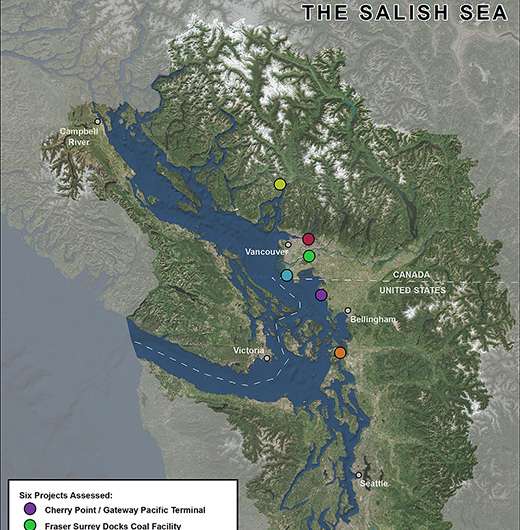Energy development impacts for the Salish Sea

Energy-related developments in the Salish Sea between Washington and British Columbia underscore the need for a transnational approach to assessing the risks to the entire ecosystem, according to a study by the SeaDoc Society, a program of the UC Davis Karen C. Drayer Wildlife Health Center, and the Swinomish Indian Tribal Community, part of the area's indigenous Coast Salish people.
The study, published in December in the journal PLOS ONE, identified six development projects proposed and underway in both Canada and the U.S. that would increase marine vessel traffic in the Salish Sea. They include plans to transport coal, shale oil, crude oil and natural gas.
"We need to deal with this at the level of ecosystem, not just project to project," said lead author Joe Gaydos, SeaDoc Society chief scientist and a UC Davis wildlife veterinarian. "When you look at these cumulatively, they have a high possibility of affecting the Coast Salish people and everyone else. The environmental impact statements aren't looking at the threats collectively."
'We believe we must walk as one'
The study evaluates the threats each project poses to 50 species important to the Coast Salish, including endangered humpback and killer whales, and key sources of food, including sea ducks, salmon, clams and Dungeness crabs.
"Since time immemorial the Coast Salish have been the caretakers of the Salish Sea," said Brian Cladoosby, Swinomish chairman. "For more than 150 years, we have lived with the destruction of our resources and environment by a pollution-based economy. It is time for a change, and this can only happen if we work together. Today we share with you a collaboration of western science and traditional ecological knowledge, policy and law, as we believe we must walk as one, with respect for one another, for the next generation."
The Salish Sea is shared by Washington, British Columbia, and indigenous Coast Salish governments. Roughly 7 million people live in the area, which includes Puget Sound, the Strait of Juan de Fuca, and the Strait of Georgia.
Though an interconnected ecosystem, the Salish Sea is managed separately across its borders. Consequently, when governmental bodies evaluate proposed developments, they rarely take into account projects occurring outside of their jurisdiction, the study notes.
"Each project has threats associated with it, and each threat has the potential to impact the 50 species," Gaydos said. "Of 300 possible threats we considered, about 25 percent were likely to impact the species evaluated. That's substantial."
The study determined that each project had potential impacts associated with increased marine vessel traffic: oil spill, vessel noise and vessel strike. These impacts could also have additive or synergistic consequences—the more vessels in the water, the higher the likelihood of a spill, for example—though to what extent is not clear.
The six projects include:
- Fraser Surrey Docks Direct Transfer Coal Facility: This approved project in British Columbia would receive up to four million metric tons of coal a year, transfer it from rail cars to marine barges to be towed down the Fraser River to the Strait of Georgia and loaded on deep-sea vessels for international export. Potential risks: those associated with marine vessel traffic, as well as shoreline development, harbor spill and coal dust.
- Gateway Pacific Terminal: A proposed deep-water terminal in Whatcom County, Washington, that would store and handle up to 54 million metric tons per year of coal products brought in by rail. Potential risks: those associated with marine vessel traffic, as well as shoreline development, harbor spill and coal dust.
- Rail shipment of Bakken shale crude oil: This ongoing project plans to increase shipping by rail of shale oil produced from the Bakken fields in North Dakota and Montana to oil refinery facilities in Washington State. Potential risks: those associated with marine vessel traffic, as well as shoreline development and harbor spill.
- Roberts Bank Deltaport Terminal 2 Project: A proposed new marine container terminal in British Columbia that would increase shipping container capacity by 2.4 million 20-foot container equivalent units per year. Potential risks: those related to marine vessel traffic, shoreline development and harbor spill.
- Trans Mountain Pipeline Expansion and Westridge Marine Terminal Expansion: Proposed new pipeline segments, pump stations, expanded terminals and dock complex in Burnaby, British Columbia, to bring more crude oil from Alberta to markets in the Pacific Rim. Potential risks: those associated with marine vessel traffic, shoreline development, harbor spill and pipeline spill.
- Woodfibre Liquefied Natural Gas Terminal. Proposal to construct a LNG production, storage and marine carrier transfer facility on Howe Sound, near Squamish, British Columbia, for the international export of 2.1 million metric tons of LNG each year. Potential risks: those associated with marine vessel traffic, shoreline development, harbor spill or nearshore explosion.
"We walk as one with our resources, as they are the spirit within us," said First Nation Summit Co Chair and Chemainus First Nation member Ray Harris. "Each day is a blessing when we see our scientists and traditional knowledge teachers sharing and incorporating one another's information. We see the removal of barriers happening all over the Salish Sea, and this respect of one another allows us to take care of this beautiful place we all call home."
More information: Joseph K. Gaydos et al. Evaluating Threats in Multinational Marine Ecosystems: A Coast Salish First Nations and Tribal Perspective, PLOS ONE (2015). DOI: 10.1371/journal.pone.0144861
Journal information: PLoS ONE
Provided by UC Davis




















